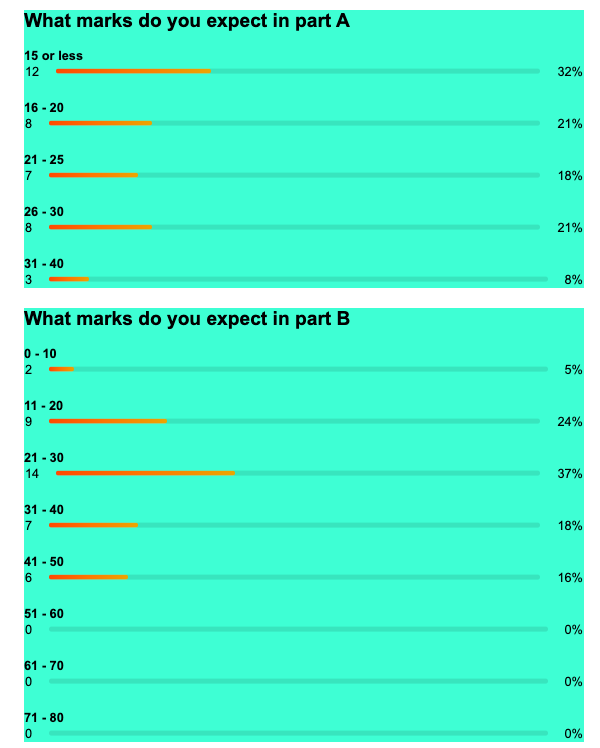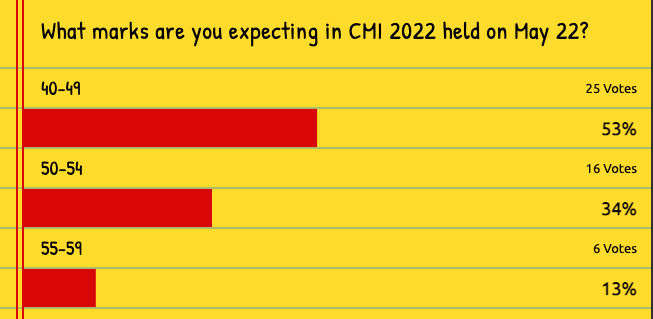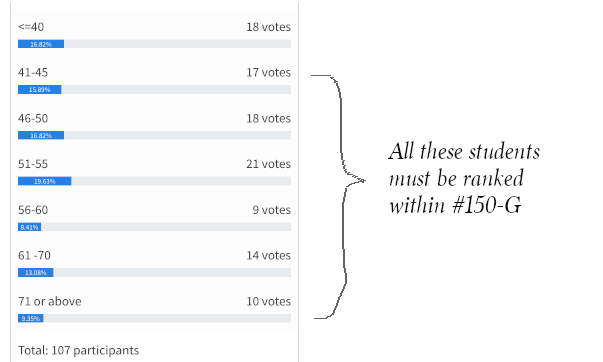Hazarding a guess at CMI ‘23 cut-off
Summary
As a fun exercise, I predict this year’s cutoff.
2023 Cut-off prediction

About ~35 students took part in the poll:

2022 Cut-off prediction

This year’s estimate is based on a simple heuristic. I expect 4-5 students who have taken the poll to qualify. Going by the poll, 57 seems to be a reasonable number.

2021 Cut-off prediction

Update: The actual cutoff was 56, so the estimate was off by 2 marks.
I arrived at the above cut-off by using three heuristics. Take it with a grain of salt since it is based on unverified assumptions. This estimate is for the general category (non-scholarship).
Heuristic 1: Comparing to previous years’ papers.
The subjective part of 2021’s paper was comparable to the previous two years’ papers. The cutoff in 2020 was 48 and 52 in 2019. Last year, problem B5’s marks was reduced to 4 due to an error. So we might normalize last year’s cutoff to 52 as well.
All three papers had three routine problems of comparable difficulty (as shown in table below). So the difficulty level of the subjective part of the question papers is roughly the same. However, the objective part was slightly easier this time. So I expect the cutoff to be a little above 52.
| 2021 | 2020 | 2019 |
|---|---|---|
| B4 | B1 | B3 |
| B2 | B2 | B2 |
| B3 | B5* | B6 |
Heuristic 2: Marks of mock test participants.
I have conducted 12 mock tests since February. The scores of students who performed consistently well lie roughly in the range of 51-64. The cutoff is likely to be in the lower quartile of that range.
Heuristic 3: Poll.
Over 100 students took part in the poll sent out last week. At first glance, the results seems to suggest that a score 70+ is needed to get through. But remember that the students visiting this site come from a pool of serious aspirants. The estimation needs to be done differently for such a biased sample. Here is one way:
Assumption: A student with 41 marks will figure within rank #150-G.
Reasoning. In 2020, CMI made about ∼60 offers in the general category. The cut-off was 48 and nine students were in the waiting list. The cut-off for the waiting list was 45.
So we know that three students tied on avg. at marks 45, 46 and 47. So even if we assume that five students were tied on marks 44,43,42 and 41, the maximum rank of the students with 41 marks is #90G.
| 2020 Marks | Rank (General) |
|---|---|
| 48 | #60G (Fact) |
| 45 | #69G (Fact) |
| 41 | #90G (Max. estimated) |
Let us generously overestimate and say that this year 41 marks is going to correspond to rank #150G. \(\;\;\;\; \square \)
What does that imply for the cutoff according to the poll? Note that there are 107-18 votes for 41+. Let us say 10 participants were in the reserved category. This means 79 students in general category have voted and have got a score of 41+.

Hence, the expected number of students within rank #60G is:
\[ \frac{79}{150}\times 60 \approx 32 \]
So, 32 students who have taken the poll should make it! This puts the cutoff closer to 56 rather than 70.
Do I believe that 32 students from the poll will qualify? No, I don’t. Students are prone to overestimating their marks. This exercise was done mainly to show that one need not be alarmed by the poll.